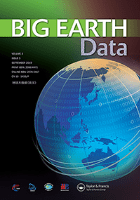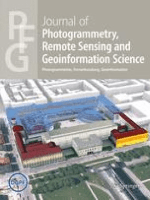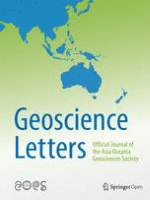
Big Earth Data
metrics 2024
Innovating Insights Through Big Data in Earth Sciences
Introduction
Big Earth Data is a prestigious open-access journal that has been at the forefront of advancing research in the intersection of earth science and computer technology since its inception in 2017. Published by TAYLOR & FRANCIS LTD in the United Kingdom, this journal is dedicated to disseminating groundbreaking findings and innovative methodologies in the fields of Earth and Planetary Sciences and Computer Science Applications. With a commendable impact factor and an impressive positioning in the Scopus rankings—claiming Q1 status in Computers in Earth Sciences and Q2 in Computer Science Applications—it serves as a vital resource for researchers, professionals, and students alike. The journal encourages submissions that explore the integration of big data technologies in managing, analyzing, and visualizing earth-related data, thereby fostering interdisciplinary collaboration. Since embracing its open-access model, Big Earth Data has enhanced the accessibility of high-quality research, promoting a broader dialogue in the scientific community and contributing to informed decision-making in global environmental challenges.
Metrics 2024
 0.93
0.93 4.20
4.20 4.70
4.70 25
25Metrics History
Rank 2024
Scopus
IF (Web Of Science)
JCI (Web Of Science)
Quartile History
Similar Journals

Earth System Science Data
Connecting Data and Discovery in Earth SciencesEarth System Science Data, published by COPERNICUS GESELLSCHAFT MBH, is a premier open access journal dedicated to advancing the field of Earth and planetary sciences. With an impressive impact factor, it holds a distinguished Q1 ranking in the Earth and Planetary Sciences category, underscoring its significance within the scientific community. Established in 2009, the journal has been committed to providing a platform for the dissemination of high-quality, freely accessible research data that supports the understanding and management of Earth's complex systems. The journal welcomes contributions that offer extensive datasets, innovative methodologies, and collaborations that push the frontiers of Earth sciences, making it an essential resource for researchers, professionals, and students alike. Based in Göttingen, Germany, Earth System Science Data remains a vital asset for those seeking to engage with and contribute to impactful scientific discourse across the globe.

Vietnam Journal of Earth Sciences
Bridging Local Insights with Global Impact in Earth SciencesThe Vietnam Journal of Earth Sciences, ISSN 0866-7187, is a premier publication from the Publishing House Science and Technology based in Viet Nam, dedicated to fostering advancements in the field of Earth and Planetary Sciences. Operating under a Q2 ranking in the 2023 category of Earth and Planetary Sciences (miscellaneous) and positioned at Rank #62 out of 195 in its general category on Scopus, this journal serves as a critical platform for researchers, professionals, and students seeking to disseminate and engage with high-quality scientific findings. Despite being part of the non-open access model, the journal is committed to providing compelling content, encompassing a range of topics from geological hazards to environmental sustainability, ensuring its relevance and contribution to both local and international scientific communities. With coverage that spans from 2018 to 2024, the journal is poised to continue its role in addressing pressing Earth science issues and fostering collaborations among scholars in an increasingly interconnected world.

COSMIC RESEARCH
Elevating Academic Discourse in Cosmic ResearchCOSMIC RESEARCH is a prestigious academic journal dedicated to advancing the field of space science, particularly within the domains of aerospace engineering, astronomy, and planetary science. Published by MAIK NAUKA/INTERPERIODICA/SPRINGER, this journal has been a significant contributor to the scholarly discourse since its inception in 1968, with converged years showing robust publication activity until 2024. With a Q4 category ranking in various disciplines, including aerospace engineering, astronomy, and space science, the journal serves as a platform for disseminating innovative research and comprehensive reviews. Although not currently offering open access, COSMIC RESEARCH is renowned for its rigorous peer-review process, ensuring that only high-quality research is shared with the academic community. The journal's ISSN is 0010-9525 and its E-ISSN is 1608-3075. Researchers, professionals, and students alike can benefit from the insights and findings presented in this journal, making it an essential resource for anyone involved in the exploration of cosmic phenomena.

Boletim de Ciencias Geodesicas
Advancing Earth Sciences Through Open Access ResearchBoletim de Ciências Geodésicas is an esteemed academic journal published by the Universidade Federal do Paraná within its Centro Politécnico. Focused on the dynamic field of Earth and Planetary Sciences, this Open Access journal has been a pivotal resource since 1997, fostering the dissemination of critical research and innovative methodologies. With an impact factor indicative of its relevance in the discipline, Boletim de Ciências Geodésicas ranks in the Q3 quartile for Earth and Planetary Sciences as of 2023, showcasing its commitment to quality scholarship in a competitive field. Researchers and students alike will benefit from access to cutting-edge findings, given its broad scope that encompasses various aspects of geodesy and related sciences. The journal's convergence of research from 2005 to 2024 ensures that it remains at the forefront of emerging trends and fundamental developments in the discipline, further enhancing its esteemed reputation in the academic community.

Journal of Geovisualization and Spatial Analysis
Illuminating Geographic Science Through Rigorous AnalysisJournal of Geovisualization and Spatial Analysis, published by SpringerNature, is an influential open-access journal specializing in the cutting-edge fields of geovisualization, spatial analysis, and their application in earth sciences and geography. Since its inception in 2017, this journal has established a prominent stance with a high impact factor and prestigious Q1 rankings across multiple categories, including Computers in Earth Sciences, Earth and Planetary Sciences (miscellaneous), and Geography, Planning and Development. The editorial board is committed to advancing innovative research and methodologies, providing a platform for scholars to disseminate their findings globally. With impressive Scopus rankings—placing it in the top percentiles among its peers—the journal serves as a vital resource for researchers, professionals, and students keen on understanding spatial data and its implications for geographic science. Its emphasis on rigorous peer review and rapid publication enhances accessibility to substantive research, thus fostering knowledge sharing within the scientific community. Based in Switzerland, the journal promotes a collaborative environment for interdisciplinary studies, making it an essential read for anyone involved in spatial analysis research.

PFG-Journal of Photogrammetry Remote Sensing and Geoinformation Science
Leading the Charge in Earth Observation TechnologiesPFG-Journal of Photogrammetry Remote Sensing and Geoinformation Science, published by Springer International Publishing AG, stands as a prestigious peer-reviewed journal at the intersection of cutting-edge technology and the vital disciplines of Earth and Planetary Sciences, Geography, and Instrumentation. With an impressive impact factor and ranking within the Q1 category, this journal regularly publishes innovative research, methodologies, and case studies that drive advancements in the field. As of its converged years from 2017 to 2024, the journal focuses on the latest trends in photogrammetry, remote sensing, and geoinformation science, providing a crucial platform for researchers, professionals, and students alike. Its open access model ensures that findings are widely accessible, fostering collaboration and knowledge dissemination throughout the global scientific community. Located in Switzerland, geographical and technological diversity is embraced, making the PFG Journal an essential resource for those dedicated to exploring the complexities of our planet and contributing to sustainable development.

Geoscience Letters
Transforming Insights into Actionable KnowledgeGeoscience Letters, published by Springer, is a prominent open-access journal in the field of Earth and Planetary Sciences, recognized for its dedication to advancing knowledge and research in this vital area of study. With a reported impact factor that reflects its esteemed position—ranking in the Q1 quartile of Earth and Planetary Sciences, particularly as the journal ranks #48 out of 195 in the general category according to Scopus—the journal serves as a vital resource for researchers, professionals, and students. Since its inception in 2014, Geoscience Letters has facilitated the dissemination of high-quality research and critical insights, aiming to bridge the gap between scientific discovery and societal needs. Its commitment to open access ensures that the latest findings are readily available to a global audience, thus enhancing collaboration and innovation within the geosciences community.

Earth Science Informatics
Transforming Geoscientific Challenges with Data-Driven Solutions.Earth Science Informatics, published by SPRINGER HEIDELBERG, serves as a premier platform for disseminating innovative research in the realm of Earth and Planetary Sciences. With an ISSN of 1865-0473 and an E-ISSN of 1865-0481, this journal offers insightful contributions that leverage informatics and data-driven approaches to address complex geoscientific challenges. As a testament to its impact in the field, it ranks in the Q2 quartile and holds an impressive 73rd percentile rank among 195 journals in the broader **Earth and Planetary Sciences** category, as per Scopus rankings. This journal invites researchers, professionals, and students to explore and contribute to the growing body of knowledge that bridges the gap between informatics and Earth science, fostering advancements in both theoretical frameworks and practical applications. Situated in Germany, at TIERGARTENSTRASSE 17, D-69121 HEIDELBERG, it aims to enhance interdisciplinary collaboration and propel scientific discovery from 2009 to 2024 and beyond, reinforcing its vital role in the academic community.

Geographia Technica
Bridging Disciplines for a Sustainable FutureGeographia Technica is an esteemed academic journal published by GEOGRAPHIA TECHNICA ASSOCIATION - GT Assoc in Romania, serving as a vital platform for the dissemination of cutting-edge research in the interdisciplinary fields of geography, planning, and earth sciences. Since its inception in 2009 and continuing through to 2024, the journal has established itself as a respected source of knowledge, reflected in its classification within the Q3 category across significant fields such as Computers in Earth Sciences, Earth-Surface Processes, and Geography, Planning and Development. With the ambition to enhance the understanding of socio-environmental interactions and technological applications in these areas, Geographia Technica invites scholars and practitioners to contribute original research that pushes the boundaries of current knowledge. Although currently not listed as open access, the journal's engaging content ensures it remains a valuable resource for researchers, professionals, and students keen on advancing their expertise in these dynamic disciplines.

IEEE Geoscience and Remote Sensing Letters
Advancing Knowledge in Earth Sciences and TechnologyIEEE Geoscience and Remote Sensing Letters is a distinguished journal published by the IEEE-INST ELECTRICAL ELECTRONICS ENGINEERS INC, focusing on the cutting-edge realms of geoscience and remote sensing. Since its inception in 2004, the journal has maintained a significant role within its field, achieving a robust impact factor that places it in the Q1 category for both Electrical and Electronic Engineering and Geotechnical Engineering and Engineering Geology, reflecting its high-quality research output and influence. The journal is highly ranked in Scopus, securing the 35th position in Earth and Planetary Sciences and the 154th position in Engineering, showcasing its broad academic reach and engagement with current advancements in technology and earth sciences. Although the journal is not open access, it remains accessible to a wide readership, fostering an environment for innovation and knowledge sharing among researchers, professionals, and students interested in remote sensing technologies and geosciences. With its objective to publish concise articles that present significant results and advancements, IEEE Geoscience and Remote Sensing Letters continues to be a vital resource for anyone engaged in these dynamic fields.